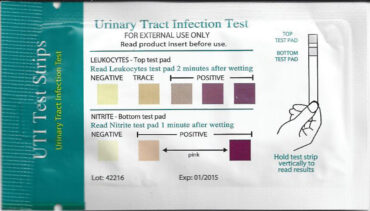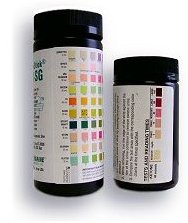
Professional Urinalysis Reagent Test Strips.
Price/OrderProfessional urine reagent test strips for the rapid determination of Glucose, Protein, pH, Leukocytes, Nitrites, Ketones, Bilirubin, Blood, Urobilinogen, and Specific Gravity (URI-10) levels in urine. The URS-UTI is a single use test specific for detection of urinary tract infections. These are the diagnostic reagent strips used by physicians, clinics and hospitals to initially screen for suspected and/or existing health conditions. Simple to use, urine diagnostic reagent strips can provide early indications of developing health problems and identify potential abnormal functions requiring more extensive testing. Additionally, routine use is frequently recommended by physicians for monitoring certain existing and chronic health conditions.
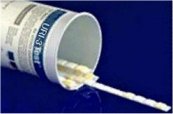
These urinalysis test strips, URS-K (Ketones) URS-3 (Glucose, Protein, pH) and URS-10 (Glucose, Protein pH, Leukocytes, Nitrites, Ketones, Bilirubin, Blood, Urobilinogen, and Specific Gravity) and URS-UTI (leukocytes and Nitrite) are simple, easy to use reagent strips for the detection of key diagnostic chemical markers in human urine. They are the same urinalysis test strips used routinely by doctors, laboratories and healthcare professionals in preliminary diagnosis of, and initial screening for potential health problems. URS-Strips are plastic strips to which chemically specific reagent pads are affixed. The reagent pads react with the sample urine to provide a standardized visible color reaction within 30 seconds to one minute depending on the specific panel screen. The color is then visually compared to the included color chart to determine the level of each chemical factor. Test results may provide useful information regarding carbohydrate (sugar) metabolism (diabetes), kidney function, acid-base balance, bacteriuria, occult blood, high leukocytes (infection) and other conditions of overall health. These urinalysis testing strips are ready to use upon removal from the vial and the entire reagent strip is disposable. URS-K, 3 & 10 reagent test strips are packed 100 tests to a vial with approximately one (1) year shelf life. Each vial comes with a complete abstract on the chemical and biological properties of the test including a color chart for rapid visual diagnosis. The URS-UTI urinary tract infection test includes one test strip per package with instructions printed on each package.
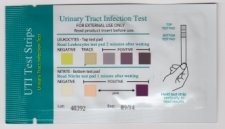
Leucocytes and Nitrites (UTI): Normal urine specimens generally yield negative results for leukocytes and nitrites; positive results of small (+) or greater are clinically significant. Individually observed 'Trace' results may be of questionable clinical significance; however, 'Trace' results observed repeatedly may be clinically significant. 'Positive' results may occasionally be found with random specimens from females due to contamination of the specimen by vaginal discharge. The presence of leukocytes in urine is referred to as pyuria (pus in the urine). The presence of nitrites in urine indicate the presence of bacteria. Primary cause: urinary tract infection, Prostatitis. The URS-UTI test is a single use, prepackaged urinalysis test kit containing one urine reagent strip for the detection of leukocytes and nitrites in urine indicating possible urinary tract infection. As with all preliminary screening urinalysis tests, a specific diagnosis should not be made without further evaluation by a healthcare professional
Is your body burning fat cells? The presence of elevated levels of ketones in human urine is a primary indicator that the body is in ketosis. Ketosis simply means that the body's stored fat cells are being utilized as a primary fuel source to produce energy. The by-products of fat metabolism are ketones. Ketones are not stored by the body and are eliminated as detectable waste products in urine. Therefore, monitoring the level of ketones is presumptive of, and directly correlated to the metabolizing, or burning of stored fat cells to produce energy. Likewise the conclusion can be drawn that the higher the concentration of ketones in urine, the higher is the amount of fat cells metabolized by the body. Ketone test strips are used routinely to help measure the progress of dieters especially those maintaining a low carbohydrate diet. Additionally, ketones are monitored in individuals with Type 1 diabetes. In diabetics, high ketone levels indicate ketoacidosis, a complication of inadequate insulin levels that can lead to diabetic coma. In overall health considerations, high ketone levels are generally an indication of abnormal nutritional conditions, including starvation, fasting, anorexia, high protein or low carbohydrate diets.
Depending on the test and specific reagent panel, abnormal levels of specific chemical compounds contained in urine can be easily and readily identified as potential risks factors to overall health and/or indicators of underlying health problems. The significance of each reagent panel is discussed in detail in the Urinalysis Technical Document.
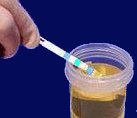
PROCEDURE AND USE:
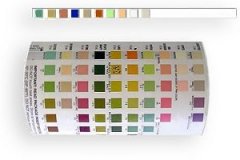
Each vial of urinalysis reagent strips includes a color coded chart. The reactive color of each panel on the test strip is compared to the closest corresponding color on the result chart. The concentration level range for each chemical marker is indicated below each color block on the result chart. As with all tests dealing with color intensity or color matching, it is often recommended to obtain another person's interpretation of the test result. Shown to the left is the color result chart for the URS-10, ten parameter test strip. Each of the ten reactive reagent pads on the test strip are compared to the corresponding line of color blocks on the chart. The closest color match indicates the test result. Use of reagent strips are intended as an initial indication only of elevated chemical markers and not conclusive of a specific diagnosis. Further testing and consultation with a healthcare professional is necessary to confirm the presence of specific disease or health conditions.
Expected values for the typical "normal" healthy population and the abnormal population are as follows:
URS-UTI, URS-K, URS-3 and URS-10 urinalysis tests strips are a intelligent first step in overall health self-evaluation. They can be an effective, low cost diagnostic aid in early detection of potential health problems. The user should remember that test results are visual and qualitative only and must be discussed with a healthcare professional prior to any conclusion or definitive diagnosis.




